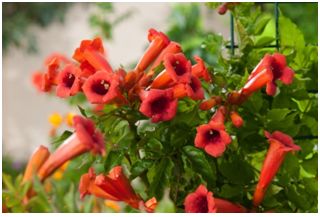
Botanical Name – Campsis radicans (L.) Seem.
Common Name - trumpet vine
Classification:-
Kingdom - Plante
Division - Magnoliophyta
Class - Magnoliopsida
Order - Scrophulariales
Family - Bignoniaceae
Genus - Campsis
Species - radicans
Characteristics Of Bignoniaceae Family-
Plant predominently lianous, compound leaves, zygomorphic flowers, anthers connivent in pairs; numberous ovule, silique-like woody capsule, large winged seed and non-endospermic. Mostly trees or shrubs; often climbing or twining vine, rarely herbs.
Habitat:- terrestial
Distribution:- Campsis radicans is native to the eastern United States and extreme southern Ontario. It is naturalized in parts of the western United States as well as in Ontario and southern Quebec, parts of Europe, and scattered locations in Latin America.
Status:- Least concern
Plant description:- Compound, odd-pinnate leaves (to 15” long) are shiny dark green above and glabrous dull green below.
Each leaf has 7 to 11 elliptic to oblong leaflets (to 4" long) with serrated margins. Leaves turn yellow in fall.
The beautiful tubular flowers range in color from yellow to orange or red.
USES-
There have been isolated cases reported of people suffering from dermatitis after handling the leaves.
There are no edible uses listed for Campsis radicans.
Can be used as a ground cover plant in a sunny position. They can be allowed to scramble on the ground and will form an effective ground cover, rooting at intervals along the branches. They should be planted about 2.5 metres apart each way.
There are no material uses listed for Campsis radicans.
The root is diaphoretic and vulnerary.